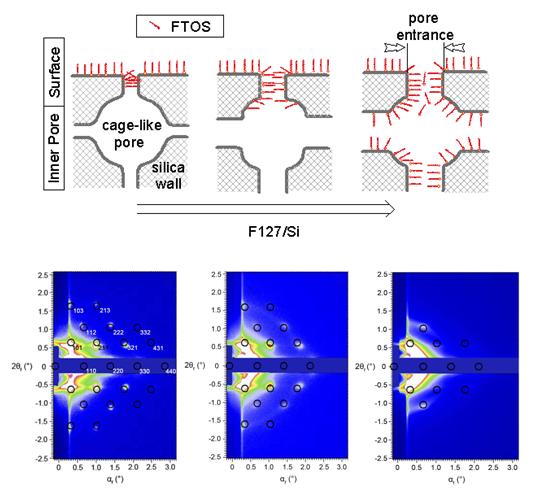| Fluoroalkyl-grafted Mesoporous Silica Antireflective Films with Enhanced Stability in Vacuum |
| From: PublishDate:2013-06-15 Hits: |
In the high power laser system, a great amount of optical surfaces were used and each component created an optical loss at the one side or two side optical surface. To reduce the surface reflective loss, antireflective (AR) films must be coated on every transmissive component. When traditional porous silica films prepared by sol-gel method were used for in high vacuum, the adsorption of some volatile organic components lowered transmittance. A team from Institute of Coal Chemistry, CAS reported a new optical AR film with enhanced environment stability. Their research has been published by OPTICS LETTERS on September 26th, 2012. The ordered cage-like mesopores silica films were formed using tetraethylorthosilicate as precursor and triblock copolymer surfactant F127 as template via evaporation induced self-assembly process, then long-chain fluoroalkylsilane was grafted by CVD method. The final AR films possess closed pore structure and hydrophobic/oleophobic surface that effectively prevents contaminant from getting into pores in film, therefore environment stability has been enhanced. Based on GISAXS and GIXRD characterizations, the ordered pore arrangement in films can be indexed as body-centered cubic mesostructure. The films exhibited excellent transmittance high as 99.98 % on quartz glass substrate. After a one-month antipollution test with polydimethylsiloxane in vacuum, the decrease of transmittance was small as 0.02 %. This film had high laser induced damage threshold of above 28 J/cm2 at 1 ns laser pulse of 1053 nm wavelength. This silica AR film has some potential as a new AR materials used in high power laser system.
The structure of ordered mesoporous films can be obtained by using synchrotron radiation at BSRF. When F127/Si molar ratio is 0.005, the films can be indexed as body-centered cubic structure. Further increasing the surfactant content, the fundamental structure information can be observed but the ordering decreased. With the help of synchrotron radiation facility, the team deeply studies structural change of the mesoporous silica films prepared under different conditions. “Generally it is difficult to obtain the detailed pore structure information in optical films that are deposited on substrates. Therefore we have not enough deep understanding in the structural evolution of film when used in special environment. The brilliant and well-collimated synchrotron beams provided us some direct and non-destructive characterizations of mesoporous films. With the structure disclosed by GISAXS, XRR, and GIXRD, the accurate control of film performance have been achieved through precisely controlling the preparation parameters.” explains professor Yao Xu, Institute of Coal chemistry, CAS.
Article: Jinghua Sun, Baohu Wu, Hongbao Jia, Dong Wu, Yao Xu* Fluoroalkyl-grafted Mesoporous Silica AR Films with Enhanced Stability in Vacuum. OPTICS LETTERS 37, 4095-4097, 2012. |
|
|
| Chinese
Science Highlights
Home /
Copyright © 2011 - 2012 Beijing Synchrotron Radiation Facility


